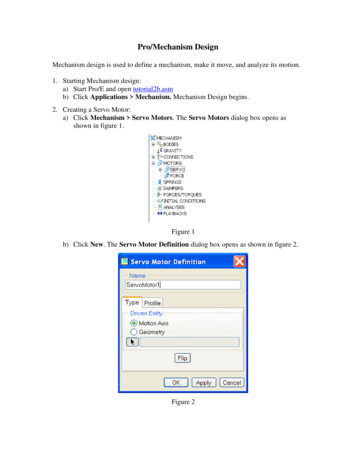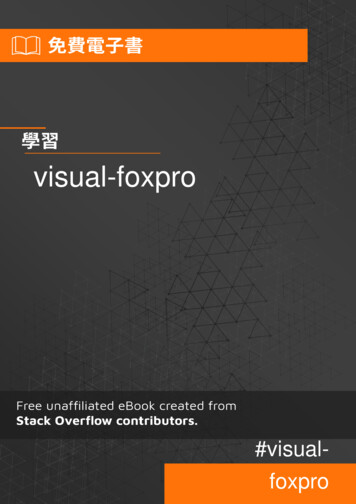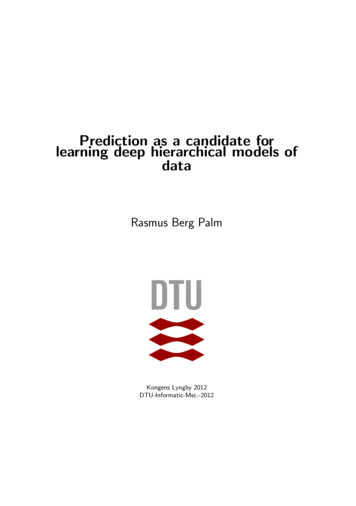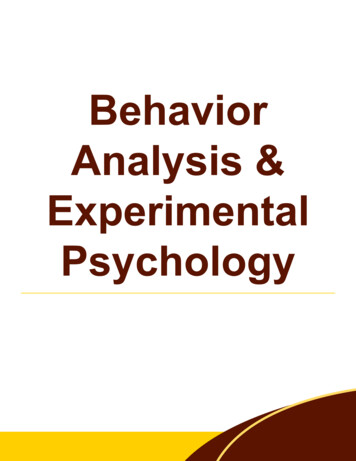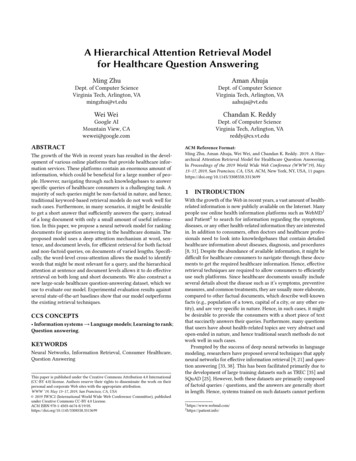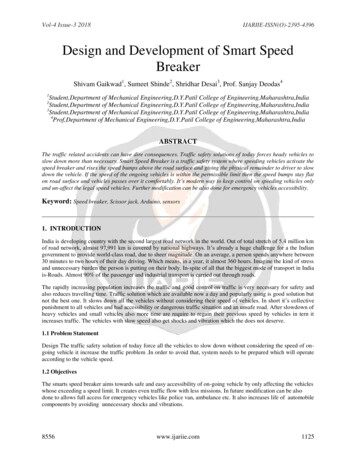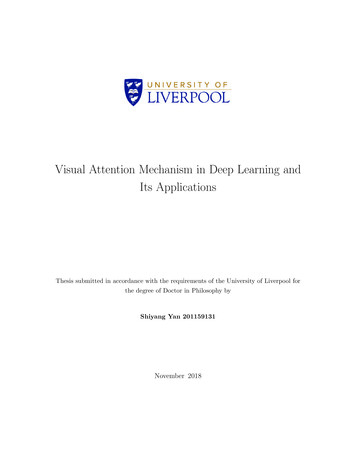
Transcription
Visual Attention Mechanism in Deep Learning andIts ApplicationsThesis submitted in accordance with the requirements of the University of Liverpool forthe degree of Doctor in Philosophy byShiyang Yan 201159131November 2018
Visual Attention Mechanism in Deep Learning and Its ApplicationsShiyang YanDedicationThis thesis is wholeheartedly dedicated to my beloved parents, who have been my sourceof inspiration and gave me strength when I thought of giving up, who continually providetheir spiritual, emotional, and financial support.To my relatives, friends, and colleagues who shared their words of advice and encouragement to finish the PhD study.i
Visual Attention Mechanism in Deep Learning and Its ApplicationsShiyang YanAbstractRecently, in computer vision, a branch of machine learning, called deep learning, hasattracted high attention due to its superior performance in various computer vision taskssuch as image classification, object detection, semantic segmentation, action recognitionand image description generation. Deep learning aims at discovering multiple levels ofdistributed representations, which have been validated to be discriminatively powerful inmany tasks. Visual attention is an ability of the vision system to selectively focus on thesalient and relevant features in a visual scene. The core objective of visual attention isto achieve the least possible amount of visual information to be processed to solve thecomplex high-level tasks, e.g., object recognition, which can lead the whole vision processto become effective. The visual attention is not a new topic which has been addressedin the conventional computer vision algorithms for many years. The development anddeployment of visual attention in deep learning algorithms are of vital importance sincethe visual attention mechanism matches well with the human visual system and also showsan improving effect in many real-world applications. This thesis is on the visual attention indeep learning, starting from the recent progress in visual attention mechanism, followed byseveral contributions on the visual attention mechanism targeting at diverse applications incomputer vision, which include the action recognition from still images, action recognitionfrom videos and image description generation.Firstly, the soft attention mechanism, which was initially proposed to combine withRecurrent Neural Networks (RNNs), especially the Long Short-term Memories (LSTMs),ii
Visual Attention Mechanism in Deep Learning and Its ApplicationsShiyang Yanwas applied in image description generation. In this thesis, instead, as one contributionto the visual attention mechanism, the soft attention mechanism is proposed to directlyplug into the convolutional neural networks for the task of action recognition from stillimages. Specifically, a multi-branch attention network is proposed to capture the objectthat the human is intereating with and the scene in which the action is performing. The softattention mechanism applying in this task plays a significant role in capturing multi-typecontextual information during recognition. Also, the proposed model can be applied in twoexperimental settings: with and without the bounding box of the person. The experimentalresults show that the proposed networks achieved state-of-the-art performance on severalbenchmark datasets.For the action recognition from videos, our contribution is twofold: firstly, the hard attention mechanism, which selects a single part of features during recognition, is essentiallya discrete unit in a neural network. This hard attention mechanism shows superior capacityin discriminating the critical information/features for the task of action recognition fromvideos, but is often with high variance during training, as it employs the REINFORCEalgorithm as its gradient estimator. Hence, this brought another critical research question,i.e., the gradient estimation of the discrete unit in a neural network. In this thesis, aGumbel-softmax gradient estimator is applied to achieve this goal, with much lower variance and more stable training. Secondly, to learn a hierarchical and multi-scale structurefor the multi-layer RNN model, we embed discrete gates to control the information between each layer of the RNNs. To make the model differentiable, instead of using theREINFORCE-like algorithm, we propose to use Gumbel-sigmoid to estimate the gradientof these discrete gates.For the task of image captioning, there are two main contributions in this thesis: primarily, the visual attention mechanism can not only be used to reason on the global imagefeatures but also plays a vital role in the selection of relevant features from the fine-grainedobjects appear in the image. To form a more comprehensive image representation, as aiii
Visual Attention Mechanism in Deep Learning and Its ApplicationsShiyang Yancontribution to the encoder network for image captioning, a new hierarchical attentionnetwork is proposed to fuse the global image and local object features through the construction of a hierarchical attention structure, to better the visual representation for theimage captioning. Secondly, to solve an inherent problem called exposure-biased issueof the RNN-based language decoder commonly used in image captioning, instead of onlyrelying on the supervised training scheme, an adversarial training-based policy gradient optimisation algorithm is proposed to train the networks for image captioning, with improvedresults on the evaluation metrics.In conclusion, comprehensive research has been carried out for the visual attentionmechanism in deep learning and its applications, which include action recognition and image description generation. Related research topics have also been discussed, for example,the gradient estimation of the discrete units and the solution to the exposure-biased issuein the RNN-based language decoder. For the action recognition and image captioning,this thesis presents several contributions which proved to be effective in improving existingmethods.iv
Visual Attention Mechanism in Deep Learning and Its ApplicationsShiyang YanAcknowledgementsI would like to express my sincere gratitude to Dr. Bailing Zhang, my primary supervisor,who provided me an opportunity for a research study and constantly guides me in thearea of machine learning and computer vision. I want to express my deep thanks to Dr.Wenjin Lu and Prof. Jeremy S. Smith, my co-supervisors, for their valuable help andsuggestions for my PhD study. I want to express my gratitude to Prof. Jeremy S. Smith,for the valuable help provided for the published papers, also, for the guidance and helpwhen I was in Liverpool. It has been a valuable journey of the PhD studies in which I havelearnt not only the research methodologies but also great perseverance during the researchprocess.I want to express my thanks to my advisors, Dr. Andrew Abel and Dr. Waleed AINuaimy, who helped to evaluate my PhD studies and provide valuable suggestions for theresearch process.I also want to thank all the co-authors of the published research, who offered advises,helps, and comments to my research, which are of great help during the PhD study.I want to extend the thanks to the lab-mates, for their help and suggestions, especially,Chao Yan, Rongqiang Qian, Yizhang Xia, Fangyu Wu and Muhammad Samer.I want to thank many friends of the Computer Science Department.I am also thankful for the help from my old friends, former colleagues and tutors.Finally, I offer my gratefully thanks to my family for their encouragement and supportall the time.v
entsixList of FiguresxiiList of TablesxivList of Acronymsxvii1 Introduction11.1Overview . . . . . . . . . . . . . . . . . . . . . . . . . . . . . . . . . . . . .11.2Motivations and Challenges . . . . . . . . . . . . . . . . . . . . . . . . . . .51.2.1Motivations . . . . . . . . . . . . . . . . . . . . . . . . . . . . . . . .51.2.2Challenges. . . . . . . . . . . . . . . . . . . . . . . . . . . . . . . .61.3Thesis Contributions . . . . . . . . . . . . . . . . . . . . . . . . . . . . . . .71.4Thesis Structure . . . . . . . . . . . . . . . . . . . . . . . . . . . . . . . . .81.5Publications . . . . . . . . . . . . . . . . . . . . . . . . . . . . . . . . . . . .9vi
Visual Attention Mechanism in Deep Learning and Its ApplicationsShiyang Yan1.5.1Periodical Papers . . . . . . . . . . . . . . . . . . . . . . . . . . . . .91.5.2Conference Papers . . . . . . . . . . . . . . . . . . . . . . . . . . . .92 Preliminaries of Deep Learning and Visual Attention Mechanism2.12.211Preliminaries of Deep Learning . . . . . . . . . . . . . . . . . . . . . . . . .112.1.1Logistic Regression . . . . . . . . . . . . . . . . . . . . . . . . . . . .112.1.2Basic Neural Network Model . . . . . . . . . . . . . . . . . . . . . .122.1.3Convolutional Neural Networks . . . . . . . . . . . . . . . . . . . . .142.1.4RNNs . . . . . . . . . . . . . . . . . . . . . . . . . . . . . . . . . . .222.1.5Generative adversarial networks (GANs) . . . . . . . . . . . . . . . .25Visual Attention Mechanism . . . . . . . . . . . . . . . . . . . . . . . . . . .292.2.1Bottom-up Visual Attention . . . . . . . . . . . . . . . . . . . . . . .292.2.2Top-down Visual Attention . . . . . . . . . . . . . . . . . . . . . . .302.2.3Recent Development of the Attention Mechanism . . . . . . . . . . .343 Contextual Action Recognition from Still Images using Multi-branch Attention Networks393.1Introduction . . . . . . . . . . . . . . . . . . . . . . . . . . . . . . . . . . . .393.2Related Works . . . . . . . . . . . . . . . . . . . . . . . . . . . . . . . . . .423.2.1Action Recognition . . . . . . . . . . . . . . . . . . . . . . . . . . . .423.2.2Attention Model . . . . . . . . . . . . . . . . . . . . . . . . . . . . .44Approach . . . . . . . . . . . . . . . . . . . . . . . . . . . . . . . . . . . . .453.3.1Classification of target person region. . . . . . . . . . . . . . . . .453.3.2Region-level Attention . . . . . . . . . . . . . . . . . . . . . . . . . .463.3.3Scene-level Attention . . . . . . . . . . . . . . . . . . . . . . . . . . .473.3.4Networks Architecture . . . . . . . . . . . . . . . . . . . . . . . . . .493.3.5Training Strategy . . . . . . . . . . . . . . . . . . . . . . . . . . . . .50Experiments . . . . . . . . . . . . . . . . . . . . . . . . . . . . . . . . . . . .523.33.4vii
Visual Attention Mechanism in Deep Learning and Its ApplicationsShiyang Yan3.4.1Experimental Setting 1 (with the bounding box of the target person) 523.4.2Experimental Setting 2 (without the bounding box of the target person) . . . . . . . . . . . . . . . . . . . . . . . . . . . . . . . . . . . .59Testing the Statistical Significance of Experimental Results . . . . .643.5Discussion . . . . . . . . . . . . . . . . . . . . . . . . . . . . . . . . . . . . .653.6Conclusion663.4.3. . . . . . . . . . . . . . . . . . . . . . . . . . . . . . . . . . . .4 Action Recognition from Video Sequences based on Visual AttentionMechanism674.1Introduction . . . . . . . . . . . . . . . . . . . . . . . . . . . . . . . . . . . .674.2Action Recognition Using Convolutional Hierarchical Attention Model . . .684.2.1Introduction . . . . . . . . . . . . . . . . . . . . . . . . . . . . . . .684.2.2Soft attention Model for Video Action Recognition . . . . . . . . . .704.2.3Experiments . . . . . . . . . . . . . . . . . . . . . . . . . . . . . . .734.2.4Conclusion . . . . . . . . . . . . . . . . . . . . . . . . . . . . . . . .78Hierarchical Multi-scale Attention Networks for Action Recognition . . . . .784.3.1Introduction . . . . . . . . . . . . . . . . . . . . . . . . . . . . . . .784.3.2Related Works . . . . . . . . . . . . . . . . . . . . . . . . . . . . . .814.3.3The proposed methods . . . . . . . . . . . . . . . . . . . . . . . . . .854.3.4Experiments . . . . . . . . . . . . . . . . . . . . . . . . . . . . . . .934.3.5Conclusion . . . . . . . . . . . . . . . . . . . . . . . . . . . . . . . . 1084.35 Image Captioning based on Visual Attention Mechanism1105.1Introduction . . . . . . . . . . . . . . . . . . . . . . . . . . . . . . . . . . . . 1105.2Image Captioning using Attention Mechanism and Adversarial Training . . 1115.2.1Introduction . . . . . . . . . . . . . . . . . . . . . . . . . . . . . . . 1115.2.2The Proposed Method . . . . . . . . . . . . . . . . . . . . . . . . . . 1135.2.3Experimental Results . . . . . . . . . . . . . . . . . . . . . . . . . . 120viii
Visual Attention Mechanism in Deep Learning and Its Applications5.2.45.35.4Shiyang YanConclusion . . . . . . . . . . . . . . . . . . . . . . . . . . . . . . . . 124Image Captioning based on Attention Mechanism and Reinforcement Learning1255.3.1Introduction . . . . . . . . . . . . . . . . . . . . . . . . . . . . . . . 1255.3.2Related Work . . . . . . . . . . . . . . . . . . . . . . . . . . . . . . . 1285.3.3Approach . . . . . . . . . . . . . . . . . . . . . . . . . . . . . . . . . 1325.3.4Experimental Validation . . . . . . . . . . . . . . . . . . . . . . . . . 140Conclusion. . . . . . . . . . . . . . . . . . . . . . . . . . . . . . . . . . . . 1516 Conclusions and Future Work1536.1Conclusions . . . . . . . . . . . . . . . . . . . . . . . . . . . . . . . . . . . . 1536.2Future Work . . . . . . . . . . . . . . . . . . . . . . . . . . . . . . . . . . . 155References157ix
List of Figures1.1The structure of this thesis. . . . . . . . . . . . . . . . . . . . . . . . . . . .82.1The neural network interpretation of Logistic Regression. . . . . . . . . . .132.2The structure of a feed forward neural network. . . . . . . . . . . . . . .142.3A typical CNN for hand-written digits recognition [1]. . . . . . . . . . . . .152.4An illustration of the convolutional operation in a CNN. . . . . . . . . . . .162.5An illustration of the max pooling operation in a CNN. . . . . . . . . . . .172.6The unfolding of the computational graph of a RNN [2]. . . . . . . . . .232.7The architecture of the LSTMs. . . . . . . . . . . . . . . . . . . . . . . . . .252.8The architecture of the GRU. . . . . . . . . . . . . . . . . . . . . . . . . . .262.9The structure of a typical GANs model [3]. . . . . . . . . . . . . . . . . . .272.10 The attention mechanism in [4] . . . . . . . . . . . . . . . . . . . . . . . . .353.1Example of similar pose leading to different actions. . . . . . . . . . . . . .403.2System diagram of our proposed Multi-branch Attention Networks. . . . . .423.3Illustration of region Attention. . . . . . . . . . . . . . . . . . . . . . . . . .473.4Illustration of scene Attention. . . . . . . . . . . . . . . . . . . . . . . . . .473.5Visualization of region attention and scene attention on the PASCAL VOC3.6test set. . . . . . . . . . . . . . . . . . . . . . . . . . . . . . . . . . . . . . .54The AP results for different categories on the Stanford 40 dataset. . . . . .58x
Visual Attention Mechanism in Deep Learning and Its Applications3.7Shiyang YanThe learnt region-attention map of HICO dataset in the experimental setting2. . . . . . . . . . . . . . . . . . . . . . . . . . . . . . . . . . . . . . . . . . .624.1The convolutional soft attention mechanism. . . . . . . . . . . . . . . . . . .704.2The system architecture of the hierarchical model. . . . . . . . . . . . . . .734.3Visualization of the attention mechanism. . . . . . . . . . . . . . . . . . . .774.4Network Structure of the HM-AN. . . . . . . . . . . . . . . . . . . . . . . .854.5The soft attention and hard attention mechanism. . . . . . . . . . . . . . .894.6Action recognition with HM-AN. . . . . . . . . . . . . . . . . . . . . . . . .934.7Some examples from the datasets used in this chapter. . . . . . . . . . . . .964.8Training cost of the UCF Sports dataset. . . . . . . . . . . . . . . . . . . .974.9Training cost of the Olympic Sports dataset. . . . . . . . . . . . . . . . . .984.10 Training cost of the HMDB51 dataset. . . . . . . . . . . . . . . . . . . . . .994.11 Confusion Matrix of HM-AN with Adaptive-Gumbel-Hard Attention on theUCF Sports dataset. . . . . . . . . . . . . . . . . . . . . . . . . . . . . . . . 1014.12 Confusion Matrix of HM-AN Adaptive-Gumbel-Hard Attention on the HMDB51 dataset. . . . . . . . . . . . . . . . . . . . . . . . . . . . . . . . . . 1054.13 Visualization of attention maps and detected boundaries for action recognition.1064.14 Visualization of temperature values with attention maps and detected boundaries for action recognition. . . . . . . . . . . . . . . . . . . . . . . . . . . . 1075.1System Diagram of the Proposed Model. . . . . . . . . . . . . . . . . . . . . 1165.2Monte Carlo roll-out. . . . . . . . . . . . . . . . . . . . . . . . . . . . . . . . 1195.3Visualization of attention maps. . . . . . . . . . . . . . . . . . . . . . . . . . 1225.4Visualization of generated languages. . . . . . . . . . . . . . . . . . . . . . . 1235.5The hierarchical attention model structure. . . . . . . . . . . . . . . . . . . 1325.6Policy Gradient optimization with a discriminator to evaluate the similaritybetween the generated sentence and the reference sentence. . . . . . . . . . 136xi
Visual Attention Mechanism in Deep Learning and Its Applications5.7Shiyang YanPolicy Gradient optimization with a discriminator to evaluate the coherencebetween the generated sentence and the image contents. . . . . . . . . . . . 1365.8Monte Carlo roll-out. . . . . . . . . . . . . . . . . . . . . . . . . . . . . . . . 1395.9The loss curve of the image caption generator during reinforcement learningsteps. . . . . . . . . . . . . . . . . . . . . . . . . . . . . . . . . . . . . . . . 1465.10 Visualization of the global attention maps and generated captions. . . . . . 1495.11 Visualization of the attentive weights on the top 10 detected objects. . . . . 1505.12 Visualization of the generated descriptions. . . . . . . . . . . . . . . . . . . 152xii
List of Tables3.1Network Configuration . . . . . . . . . . . . . . . . . . . . . . . . . . . . . .3.2Efficiency Analysis of the proposed model on a PC embedded with a TITAN49X GPU . . . . . . . . . . . . . . . . . . . . . . . . . . . . . . . . . . . . . .523.3The AP results on PASCAL VOC validation set . . . . . . . . . . . . . . .523.4Comparison of each of the three branches and their random combinationson PASCAL VOC validation set. . . . . . . . . . . . . . . . . . . . . . . . .533.5The AP results on PASCAL VOC test set533.6The AP results on the Stanford 40 dataset and comparison with previousresults. . . . . . . . . . . . . . . . . . . . . . . . . . . . . . . . . . . . . . . . . . . . . . . . . . . . . . .583.7The AP results on PASCAL VOC validation set (experimental setting 2) .603.8The AP results on PASCAL VOC test set (experimental setting 2)603.9The AP results on the Stanford 40 dataset with experimental settings 2.613.10 The mean AP results on the HICO dataset with experimental settings 2.63. . . . . . . . . . . .644.1Accuracy on UCF sports . . . . . . . . . . . . . . . . . . . . . . . . . . . . .754.2AP on Olympics sports. . . . . . . . . . . . . . . . . . . . . . . . . . . . .764.3Accuracy on HMDB51 . . . . . . . . . . . . . . . . . . . . . . . . . . . . . .764.4Comparison with related methods on HMDB51 . . . . . . . . . . . . . . . .764.5Networks Structure Configuration. . . . . . . . . . . . . . . . . . . . . . . .953.11 P-value for the Obtained Results in the Experimentsxiii. . . .
Visual Attention Mechanism in Deep Learning and Its ApplicationsShiyang Yan4.6Number of Iterations and Epoches for Convergence on Different Datasets. .4.7Accuracy on UCF Sports using Adaptive-Gumbel-Hard Attention with different sequence lengths. . . . . . . . . . . . . . . . . . . . . . . . . . . . . .95994.8Accuracy on UCF Sports . . . . . . . . . . . . . . . . . . . . . . . . . . . . 1004.9AP on Olympics Sports . . . . . . . . . . . . . . . . . . . . . . . . . . . . . 1024.10 Accuracy of Softmax Regression on HMDB51 based on Different Features . 1044.11 Accuracy on HMDB51 . . . . . . . . . . . . . . . . . . . . . . . . . . . . . . 1044.12 Comparison with related methods on HMDB51 . . . . . . . . . . . . . . . . 1045.1Comparison of image captioning results on the COCO dataset with differentimage encoders . . . . . . . . . . . . . . . . . . . . . . . . . . . . . . . . . . 1215.2Experimental validation of the improvement by using Monte Carlo roll-out5.3Comparison of image captioning results on the COCO dataset with previous121methods . . . . . . . . . . . . . . . . . . . . . . . . . . . . . . . . . . . . . . 1225.4Comparison of image captioning using different attention mechanism resultson the COCO dataset . . . . . . . . . . . . . . . . . . . . . . . . . . . . . . 1455.5Comparison of image captioning results on the COCO dataset with differentnumbers of objects . . . . . . . . . . . . . . . . . . . . . . . . . . . . . . . . 1475.6Comparison of image captioning results on the COCO dataset with differentsettings for policy gradient (PG) optimization . . . . . . . . . . . . . . . . . 1475.7Comparison of image captioning results on the COCO dataset for policy gradient (PG) optimization with discriminator for evaluation of the coherencebetween language and image content.5.8. . . . . . . . . . . . . . . . . . . . . 147Comparison of image captioning results on the COCO dataset with previousmethods, where 1 indicates external information are used during the trainingprocess andmodel.2means that reinforcement learning is applied to optimize the. . . . . . . . . . . . . . . . . . . . . . . . . . . . . . . . . . . . . . 148xiv
List of AcronymsAP Average Precision.ATT Attention Models.BoVW Bag of Visual Words.CHAM Convolutional Hierarchical Attention Model.CNNs Convolutional Neural Networks.COCO Common Objects in Context.Conv-Attention Convolutional Attention Model.DCC Deep Compositional Captioning.DNN Deep Neural Network.DPM Deformable Part Model.FC-Attention Fully Connected Attention Model.GANs Generative adversarial networks.GRU Gated Recurrent Unit.xv
Visual Attention Mechanism in Deep Learning and Its ApplicationsHAN Hierarchical Attention Networks.HC Histogram-based Contrast.HICO Humans Interacting with Common Objects.HM-AN Hierarchical Multi-scale Attention Networks.HM-RNN Hierarchical Multi-scale Recurrent Neural Network.ILSVRC-2012 ImageNet Large Scale Visual Recognition Challenge-2012.LSTMs Long Short-term Memories.MaliGAN maximum-likelihood augmented discrete GAN.mAP mean Average Precision.MLE Maximum Likelihood Estimation.MLP Multi-layer Perceptron.NLP Natural Language Processing.RC Region-based Contrast.ReLU Rectified Linear Unit.RL Reinforcement Learning.RNNs Recurrent Neural Networks.RoI pooling Region-of-Interest Pooling.SGD Stochatic Gradient Descend.xviShiyang Yan
Visual Attention Mechanism in Deep Learning and Its ApplicationsSPP Spatial Pyramid Pooling.VQA visual question answering.xviiShiyang Yan
Chapter 1Introduction1.1OverviewMachine learning has powered many aspects of modern society: from conventional industryto current internet business like web search engine, social networks, and content filtering.It is continuing to increase its impact on modern life. To name a few, the functionalitiesof machine learning include recognising objects in images, translating one language toanother, match news items, recommending news based on user’s interests and of course,select the relevant results in search engine.Recently, one of the branches of machine learning family called deep learning has showndominant performance in tasks mentioned previously and becomes increasingly importantin machine learning and artificial intelligence. Conventional machine learning techniqueswere limited in their ability to process natural data in their raw form. For decades, constructing pattern recognition system required careful engineering and considerable domainexpertise to design a feature extractor that transformed the raw data into a suitable internal representation or feature vector from which the learning subsystem, often a classifieror predictor, could classify or predict patterns in the input. These hand-crafted features,if not appropriately designed, could severely deteriorate the system performance. On the1
Chapter 1. Introduction2other hand, representation learning, which deep learning belongs to [2], is a set of learning methods which can be fed with only raw data and automatically discover the internalrepresentation of the data during the process of learning.[5] has given an empirical view of what the representation learning means, taking theexample of one of the most popular models in deep learning called Convolutional NeuralNetworks (CNNs) [6]. In [5], the authors visualize each of the layers in the trained CNN tofind what each layer represents. Interestingly, an image, for example, comes in the form ofan array of raw pixels, and the learned features in the first layer of representation usuallyrepresent the presence of edges at particular orientations and locations in the image. Thesecond layer typically detects motifs by spotting specific arrangements of edges, regardlessof small variations in the edge positions. The third layer may assemble motifs into largercombinations that correspond to parts of familiar objects, and subsequent layers woulddetect objects as combinations of these parts. The representation of the CNN becomesmore abstract in the higher layers than the lower layers. The CNN is only an example ofrepresentation learning. Not just the CNNs model but also other models like RNNs showexcellent performance in various machine learning tasks. The RNNs are especially good inthe sequence-to-sequence problem, which is very common in many real-world applications.For instance, machine translation, image captioning, action recognition and some problemsassociated with video or language are all sequence-based recognition tasks. The RNNs tryto model the sequence evolution of the features by using recurrent connections, whichproved to be effective in modeling the sequential dependencies.Meanwhile, it has been found in the literature that humans do not focus their attentionon an entire scene at first glance [7]. Instead, they retrieve parts of the scene or objectssequentially to find the relevant information. The visual attention mechanism had longbeen the research topic in neural science, computer vision, and machine learning. Mostof the conventional computer vision algorithms applied visual attention mechanism onlybased on the low-level raw features to find the saliency. With the rapid development in
Chapter 1. Introduction3representation learning and deep learning, more research learns the internal representations automatically during the training process. This technology also empowers the visualattention model to automatically retrieve relevant information for the specific task insteadof solely relying on static low-level image features. Attention-based models have beenshown to achieve promising results on several challenging tasks such as neural machinetranslation [8], image captioning [4] and action recognition [9].The visual attention models are mainly categorised into bottom-up models and topdown models [10]. The bottom-up attention models are mainly driven by the low-levelfeatures of the visual scene. The goal of bottom-up attention is to find the salient points,which stands out from its surrounding and attracts our attention at first glance. Most ofthe traditional bottom-up attention models rely on hand-crafted low-level image featuressuch as colour and intensity to produce saliency map. Most of the recently applied andeffective visual attention mechanism in deep learning field belongs to the family of the topdown attention. The top-down attention is learnt in the training process and mainly drivenby the discriminative training. It tries to learn the crucial features which are useful for thetask at hand. This basic idea of grasping the crucial features introduces the main researchtopic of this thesis, which drives us to research into the mechanism of visual attention andits application in many real-world tasks.In this thesis, following the basic idea of the visual attention, we employed, extendedand improved the current visual attention mechanism in several computer vision tasks,which include the action recognition from still images, the action recognition from videosand the image description generation. The action recognition from still images is a humanrelated image recognition problem, the action recognition from videos are video-basedrecognition task, and the image description generation is an image understanding problem.In this thesis, the three important applications of computer vision can be realised with theaid of the visual attention mechanism to improve the final performance in challengingdataset. For action recognition from still images, the contextual information associated
Chapter 1. Introduction4with the human is what the attention mechanism try to capture; for action recognition fromvideos, the crucial information in the spatial and temporal domain is what the attentionmechanism focuses; for image description generation, the attention mechanism is to alignthe corresponding object features with the generated word automatically, which is of vitalimportance this kind of language-related problem.Corresponding to the three topics, we carried out three pieces of research, all based onthe visual attention mechanism: Many of the previously visual attention mechanism is associated with the RNNs,which tries to allocate attention region by considering the temporal dependencies.In our research [11], the visual attention mechanism is shown to be powerful infeedforward networks. By applying the multi-branch attention networks in the CNNmodel, action recognition from still images can be successfully realised. For action recognition from videos, the visual attention mechanism is extended toconvolut
Deep learning aims at discovering multiple levels of distributed representations, which have been validated to be discriminatively powerful in many tasks. Visual attention is an ability of the vision system to selectively focus on the salient and relevant features in a visual scene. The core objective of visual attention is
